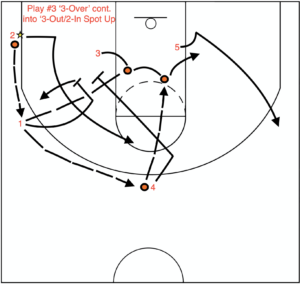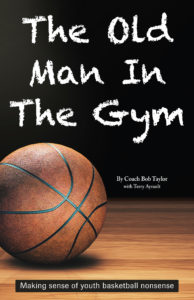Integrating Ball Screen & Rim-Runs into Man Offenses
Ball screen-and-rolls have become increasingly more popular in the last several years. Defensive-minded coaches have tried to counter this fundamentally sound offensive way of attack with various methods, such as switching the ball screen, hedging, hard-hedging, trapping, and other methods. Offensive-minded coaches have then tried to counter these defensive adjustments in order to be able to keep using this type of attack.
One method that can drastically discourage defensive hedging, switching, and trapping ball screens has been the rim-run. This technique does away with the traditional ball-screener pivoting off of the lower foot, opening up to the dribbler, and then rolling to the basket to post up. Instead, the ball-screener now turns in the opposite direction off of the same lower foot and runs towards the basket. Gone is the slower, mechanical, and stronger posting up on the block used in the screen-roll and now the footwork is a much quicker (and athletic) run to the basket, looking for a lob pass technique. Defensive hedgers will not be able to catch up to the rim-runner if they step out at all to help their ball-defender teammate.

Shown in Diagram 01 is Play #1. This entry is executed out of the “1-DOWN” Set, which means the play can have a great deal of unpredictability since the strong and weak sides can easily be modified with only 05 having to change sides of the lane. In this example, 05 starts on the block on the left side of the floor. 01 does not have to but could start by dribbling towards 03 (on 05’s side of the floor.) As 01 approaches 03, 05 can make a strong duck-in cut into the imaginary dotted circle area of the lane. X5 will have no help-side and interior support to properly deny 05 the ball from 01. But if 01 elects not to make the lob or bounce pass to 05 (depending on how X5 defends 05), 01 continues towards 03. 03 sets his defender up before then scraping off of 01 to receive the hand-off. After just one or two dribbles, 03 should swing the ball to 02 out on top. See Diagram 01.

If 02 does not have the opportunity to go inside to 05 on his second duck-in cut into the middle of the lane (with no apparent support defense given to X5), 02 waits for 04 to break up to set a long big-on-small ball screen near the high elbow area outside of the 3-point arc. By that time, 05 has cut across the lane to post up on the new ball-side mid-post block. As 02 dribble-scrapes off of 04’s screen, 04 then rim-runs towards the basket for a lob pass. With 05 flashing to the ball-side post and 03 & 01 outside of the arc; X4 will have no support defense. If X4 has hedged out to slow down 02’s dribble, X4 will be caught behind 04 on his lob cut to the rim. If X4 and X2 switch the 04-02 ball screen, 04 should have a height and player position advantage as well as the inside track to the basket. Still, if 02 does not make the inside pass to 05, the lob pass to 04, or does not create off of his dribble; all five offensive players are in the proper “3-Out/2-In” Spot-Up locations for the second and last phase of the offensive attack to smoothly and fluidly begin. See Diagram 02.

Play #2 is to be run out of the “HI-LO STAX” Set. 05 and 03 could be in the high stack on the opposite side of the floor as well as 04 and 02 stacking together as the low stack on the other side of the floor. In this example, 05 and 03 start on the left side with 04 and 02 on the offense’s right side. Regardless, 01 must always dribble towards the high stack. Diagram 03 has 01 dribble off of 05’s big-on-small ball screen. At the same time, 04 pin-screens for 02 to break out to his wing area and then flashes across the lane to post up on the newly declared ball-side mid-post block. As 01 dribble-scrapes off of 05’s ball-screen, 03 makes a pipe-cut to the (now vacant) top of the key. Again, as 01 approaches the free-throw line extended, 05 then rim-runs towards the basket; looking for a lob pass from 01. 01 should look first to make an inside pass to 04, then a lob pass to 05, a skip pass to 02, or a reverse pass to 03. If no shots are taken, all five players are in the proper “3-Out/2-In” Spot-Ups so that the offense can maintain its assault on the defense. See Diagram 03.

Play #3 is to be run out of the “3-OVER” Set. 02 and 03 could also align on the right side of the floor, but this diagram shows those two players overloading the offense’s left side of the floor. 01 must always use the ball screen on the overloaded side of the offense. 05 then is the post player that sets a big-on-small ball screen before then quickly rim-running to the basket and eventually to the newly declared post area. As soon as 01 turns the corner off of 05’s top shoulder, 03 makes a strong duck-in cut, towards the imaginary dotted circle in the middle of the lane. 04 slips out to the now empty top of the key area. 02 remains spotted up in his original deep corner, looking for a quick catch-and-shoot off of 01’s pass. 04 and 02’s current locations will vertically and horizontally stretch the opposition’s defense so that it is weakened in the interior, giving 03 and 05 excellent chances for inside shot opportunities. If no shots are taken, all players are in the “4-Out/1-In Secondary Break” Spot-Ups. See Diagram 04

If 01 turns down the lob pass to 05 and either 02 or 01 does not make the inside pass to 03; the ball should be reversed to 04 at the top of the key. When the ball is reversed to 04, 04 looks to make an inside pass to 03 when he makes the duck-in cut into the middle of the lane. With the ball centered up in 04’s hands at the top of the key; there is no defined defensive ball-side or help-side. That means that there should not be any type of interior support for an exposed (and inexperienced) perimeter defender that is caught inside. Regardless of how X3 tries to defend 03 on his duck-in cut, 03 should have an answer for whatever method X3 attempts to use.
» ALSO SEE: Integrating Ball Screen-and-Rolls into Man Offenses
If 04 decides not to go inside to 03, he can swing the ball to the inverted post player (05) out on the free-throw line extended. 03 chases the ball and posts up on the new ball-side mid-post area. As soon as 04 makes that pass, 04 and 01 then set a big-on-small stagger-screen for 02 to use as he breaks to the top of the key for an open 3-point shot. After the stagger-screen, 04 slides down to the new weakside post area, and 01 floats back out to the new weakside wing area. This stagger-screen not only provides the offense with an outstanding chance for a 3-point shot for 02, but this action also should help eliminate any chance of help-side defense that X3 should need to successfully defend 03 down on the block. See Diagram 05.

Play #4 is to be run out of the “Twins” Set and since this alignment is a balanced set; 01 could decide on dribbling towards either side of the floor. After it has been declared that the right side is to be the action side, Diagram 06 illustrates 01 dribble-scraping off of 04’s big-on-small ball screen and 05 making his diagonal slash-cut across the lane to post up on 01’s new ball-side mid-post. When 02 sees 01 appear outside of 04’s ball-screen, he pops out to his side’s deep corner area, while 03 breaks diagonally up to the top of the key. 01 can make the inside pass to 05 or to 02 for him to make the inside pass to 04. 01 could also look to make the lob pass to 04 on his rim-run cut. If 04 does not receive the lob pass, 04 should curl back out to the new weakside wing area. This cut will help eliminate any possible weakside defense that X5 would need if he wants to front 05 in the post. If X5 does not front 05, either 01 or 02 should be able to make a bounce pass inside to 05 for a possible high percentage inside shot. If 01 turns down all of those three possible passes, 01 could also reverse the ball to 03 out on top of the key. If no shots are taken, all five players are in the proper “4-Out/1-In” Secondary Break Spot-Ups so that the offense can maintain its assault on the defense. See Diagram 06.

As the name states, these particular spot-up positions are the same spot-ups that many secondary breaks have if no shots are created off of the designated break. The same action that can flow after the Secondary Break can be utilized. This action shows 03 with the ball out on top with four of the five offensive players outside of the 3-point arc. Upon seeing the ball move from 02 to 01 and on to 03, 05 constantly tries to reposition himself and seal off of his post defender. When 03 has the ball centered up, there is no established “defensive weakside and ball-side.” This will put X5 at a huge disadvantage in trying to defend 05 on his duck-in cut. Just after 03 receives 01’s reverse pass, 04 steps up and over to set a big-on-small long ball screen to be able to free up 03 on his dribble to the left side’s free-throw line extended. As 03 dribbles off of 04’s top shoulder, 04 then makes his rim-run cut to the basket. 05 has continued his method of chasing the ball as the ball goes around the perimeter. When 03 reaches the free-throw line extended, 05 should be settled in at the new ball-side mid-post block area. Both 02 and 01 rotate around the perimeter outside of the arc to help fill the “3-Out/2-In” Spot-Ups. This enables the offense to continue attacking and not allowing the opposition’s defense to be able to regroup, recover, or reorganize — putting the defense at a great disadvantage. See Diagram 07.

These four plays are executed out of four different sets/alignments all are utilizing the rim-run cut to its maximum potential. In addition to this all-important building block, there are at least 15 other building blocks that are integrated in these four plays/entries.
Obviously, other plays can be designed either out of these sets or out of various other sets. These four plays or any additional plays should not be used unless those plays utilize that team’s individual players’ skills and talents, while also minimizing those players’.









